After an afternoon of cliff diving into waterfalls on the MacLehose Trail in Hong Kong, a group of ramblers is heading back to camp. A set of tents punctuate a secluded beach just off the famous hiking path that runs through the mountainous region of the city. As they stand atop a nearby hill looking down at their home for the weekend, they spot a small animal wandering carelessly between their tents.
As they approach, the beast’s figure becomes clear and it quickly dawns on them… this is no small animal. Tents have been ripped, pegs pulled from the ground and rucksacks have been torn open in an attempt to find food. The beautiful, secluded beach is not just home to happy campers, but also wild boar.
“One of the guys was pretty tired and decided not to come to the waterfall and get some sleep in the tent,” Lukas Koszuk, co-founder of Pacha Mama Adventures recalls to That’s. “He was terrified because it was his first ever camping experience and while he was sleeping, a wild boar destroyed our camp.
“The boar didn't do anything to him because he started making loud noises and it ran away. But that particular boar was very stubborn and kept bothering us all night.”
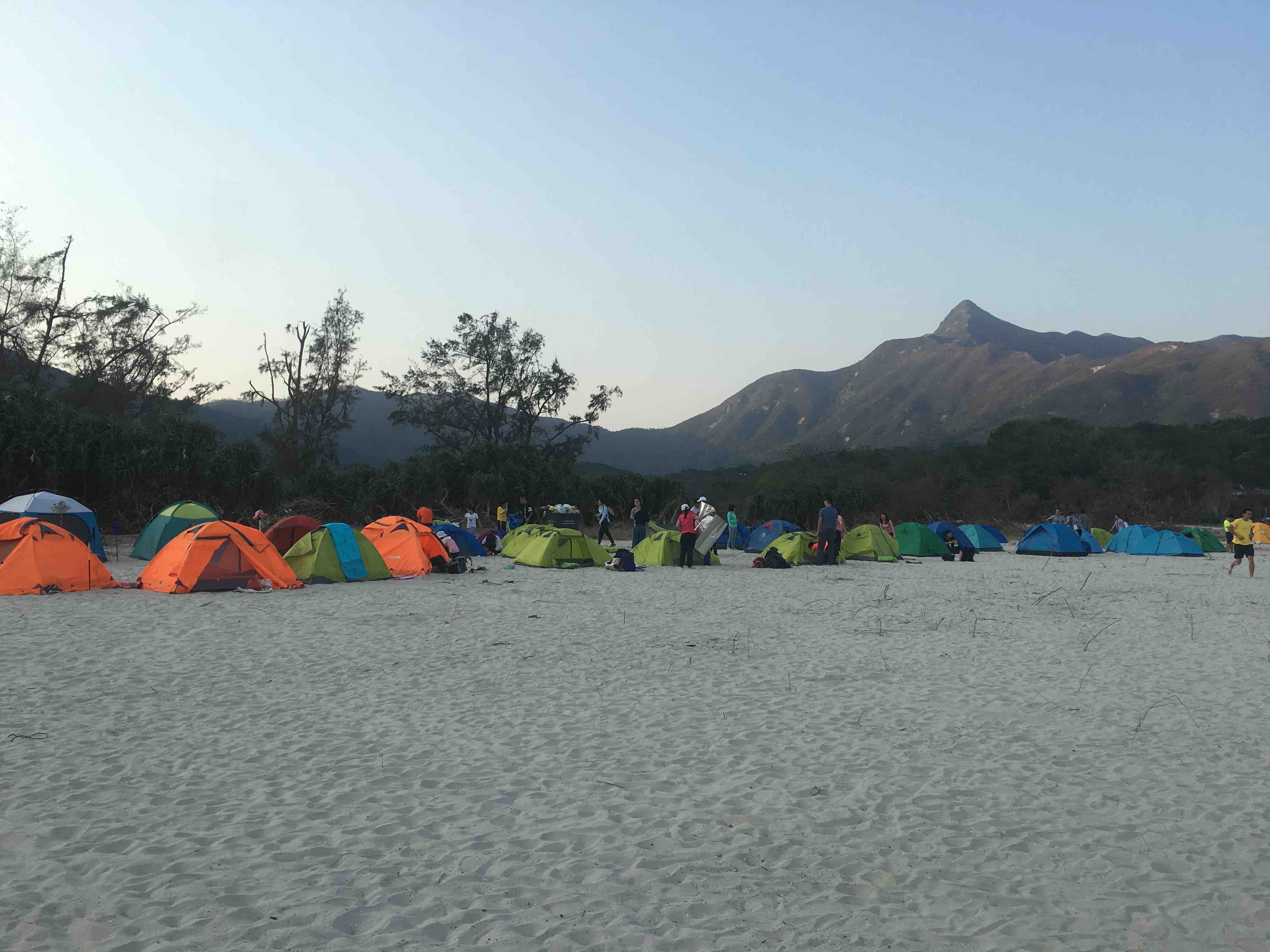
Koszuk and friends setting up camp on Ham Tin Beach, Hong Kong. Image via Pacha Mama Adventures
You might think that such stories would be enough to put a lot of people in China off camping for good, but the reality is quite different. During this year's Labor Day holiday, which ran from April 30 until May 4, searches for 露营 (luying), the Chinese word for camping, increased by 90%.
The phenomenon is not only a popular way for people in China to spend the holidays. In 2020, Radii reported that on Xiaohongshu (China's Instragram-like platform) there had been a 271% increase in camping-related posts compared to the year previous.
Anwar Bennett is a seasoned camper who has pitched tents across three different continents, including countries like the UK, South Africa and China. He explains that “Camping has blown up in China, I think it’s because of COVID-19. People are less willing to travel outside of their provinces now, so you're finding a lot of people who want to do something on the weekends are going camping. They don't want to go to another city because of lockdowns and restrictions and stuff like that. Camping has kind of snuck its way in.”
Bennett and Koszuk are camping purists and outdoor lovers. They both regularly go on camping expeditions to get away from the city and connect with nature, something that can be difficult when living in huge metropolises like Guangzhou, where they both reside.
For Bennett, camping in China began a couple of years after he first arrived in 2013. “When I was younger, I would go on camping trips with my family every month or so. And then after living in China for a couple of years, I started looking online for places to go.”
The 37-year-old from London tells That’s that it's not a true camping trip if he’s not riddled with mosquito bites, covered in mud and had to search hard for an ideal spot to pitch his tent where he can spend the night looking at the stars.
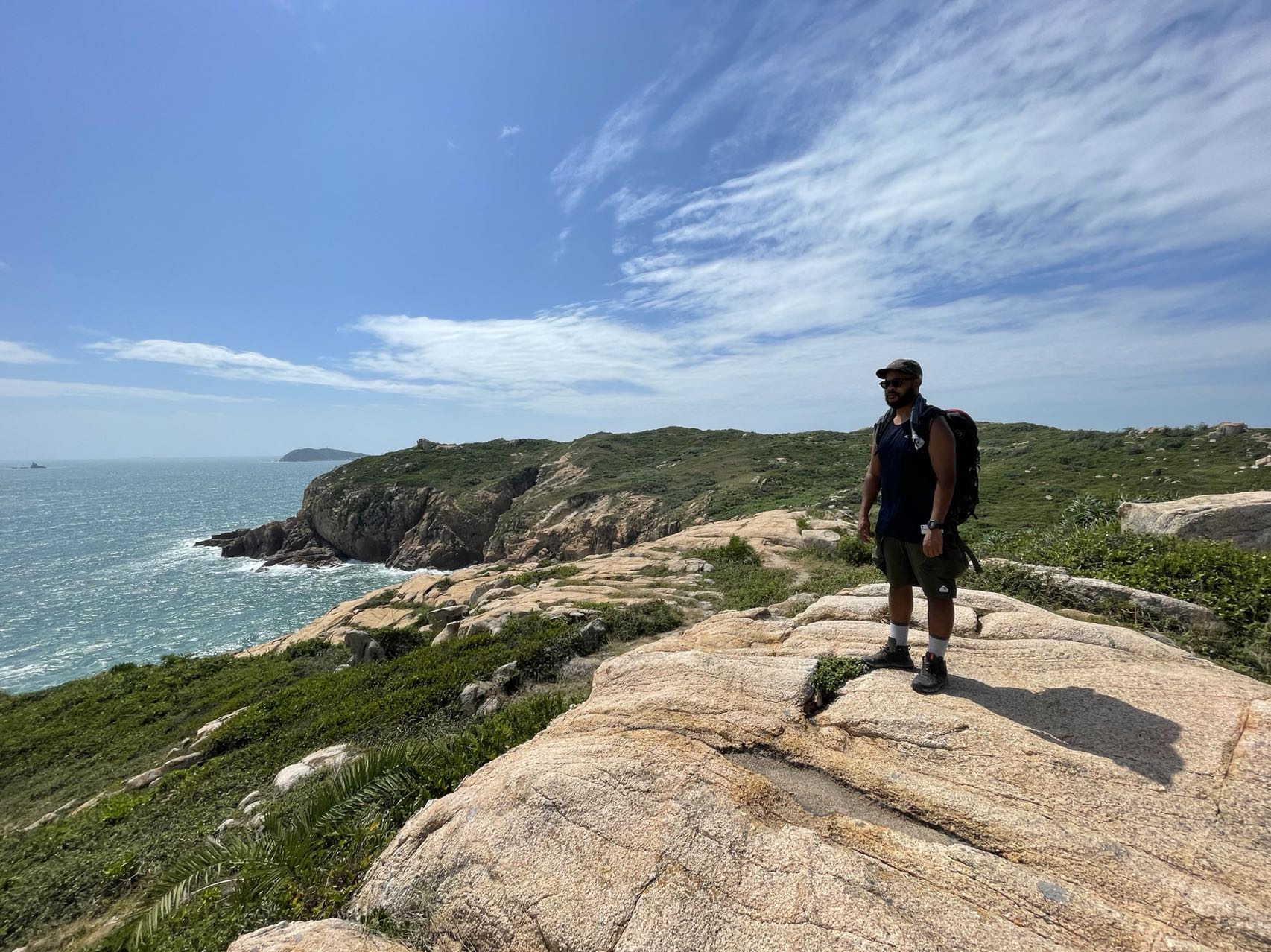
Bennett at one of his favorite camping spots in Shenzhen. Image via Anwar Bennett
Koszuk’s journey into camping in China is a little different. In 2017 he co-founded Pacha Mama Adventures (a travel agency) as a way to offer people in the country a convenient way to explore remote regions of the Middle Kingdom, such as Sichuan and Yunnan provinces. When scouring the country for new places to visit, he would always pack a tent in case he had difficulties finding hotels or he was too far away from the city to make it back before nightfall. He quickly discovered that the camping experience made the journey all the more worthwhile. Thus, he started organizing hiking camping trips as Pacha Mama Adventures.
However, this form of camping, commonly known as ‘wild camping,’ where campers stay away from campsites and opt for the depths of a forest or the peak of a mountain, is not what has gripped this new generation of campers in China.
A quick search on 携程旅行 (xiecheng lüxing), the Chinese language APP for Trip.com, highlights that the most popular places for people on the mainland to go camping are those that offer ‘glamping’ experiences.
This is only further reiterated by looking at the data released by Trip.com for the Labor Day holiday: “Searches for hotels or glamping near popular camping spots increased by 153%.” This could highlight that many people want the outdoor experience of camping, without the down and dirty business that comes with camping itself.
Glamping is different from camping in the sense that the tents are luxurious and, in some cases, akin to hotel rooms. They can be equipped with electricity to power TVs and air conditioners, double beds with a mattress and even room service if at a designated glamping spot.
Glamping takes away the hard work like hiking, lugging heavy bags around and spending time researching the perfect spot to pitch up, all the things that make a camping experience for the purists. However, glamping makes sense for a lot of people new to the fad “since over 90% of Chinese campers only spend one night in the tent,” according to an article by Daxue Consulting. Albeit more expensive than traditional camping, more and more people are starting to collect their own glamping gear and take over wild camping spots.
“There’s a really cool camping place in Jiangmen, Guangdong. It’s on a hill, but the hill has layers that you can camp on,” recalls Bennett, discussing his experience of watching glampers invade one of his favorite camping spots.
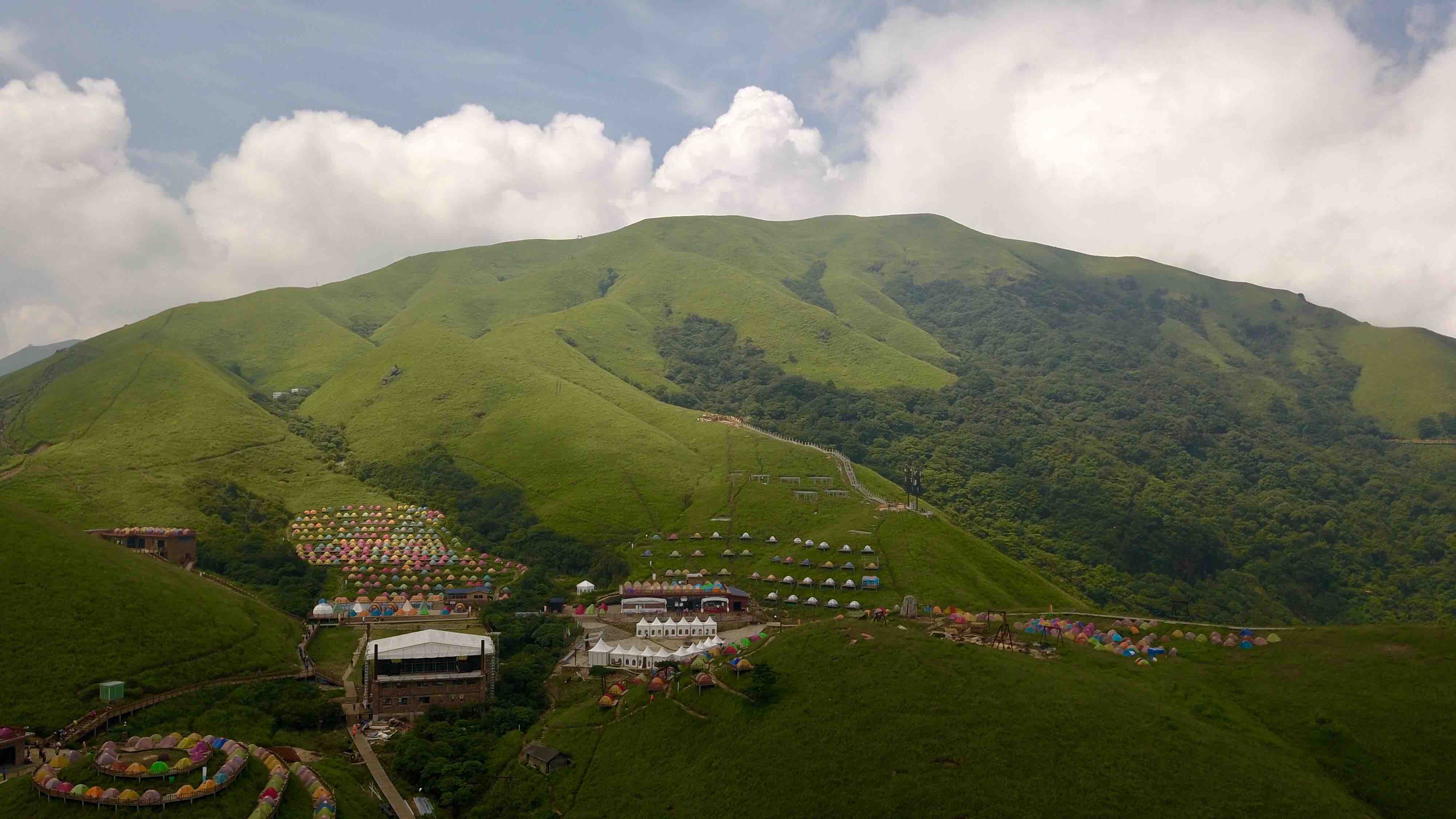
Camping at the base of Wugong Mountain, Jiangxi province. Image via Pacha Mama Adventures
“When we were there, this guy turned up with his wife and set up an RMB15,000 Snow Peak tent, a double bed raised off the ground, a power generator and a fan, all of which he needed a Jeep to carry.
“Anyway, so my friends and I are just sitting around the fire chatting, having a beer and all of a sudden, the guy pulls out a lighting rig and starts doing a full photoshoot! What’s even funnier is by the time we woke up the next morning, he was already packing up and leaving.”
Outdoor activities have become an increasingly popular way for people in China to pass the time. Their antics are regularly posted on popular social media sites. A term known amongst Chinese people as 打卡 (daka) is used to describe clocking into Instagram-worthy spots.
Bennett also mentioned that he’s seen glampers rock up to campsites with full KTV rigs and projectors, spending the night singing love songs and watching movies rather than enjoying the natural surroundings.
“It’s kind of funny, I think that camping for some is not the same as the traditional camping that I think of, it's something different,” Bennett explains. “If you're taking projectors and having photoshoots, it seems like you're looking for some sort of entertainment or want the pictures rather than the experience.”
Bennet interjects that he’s not generalizing all campers as people looking for easy likes on social media or that they are all looking to be seen as doing something, rather than actually doing it. He believes that glamping should be viewed as something different from camping entirely, more like a luxury holiday.
More and more campsites are starting to offer glamping experiences, and they also have activities that travelers can take part in, such as rock climbing and movie nights. Koszuk has also noticed that camping in China is moving towards a glamping culture.
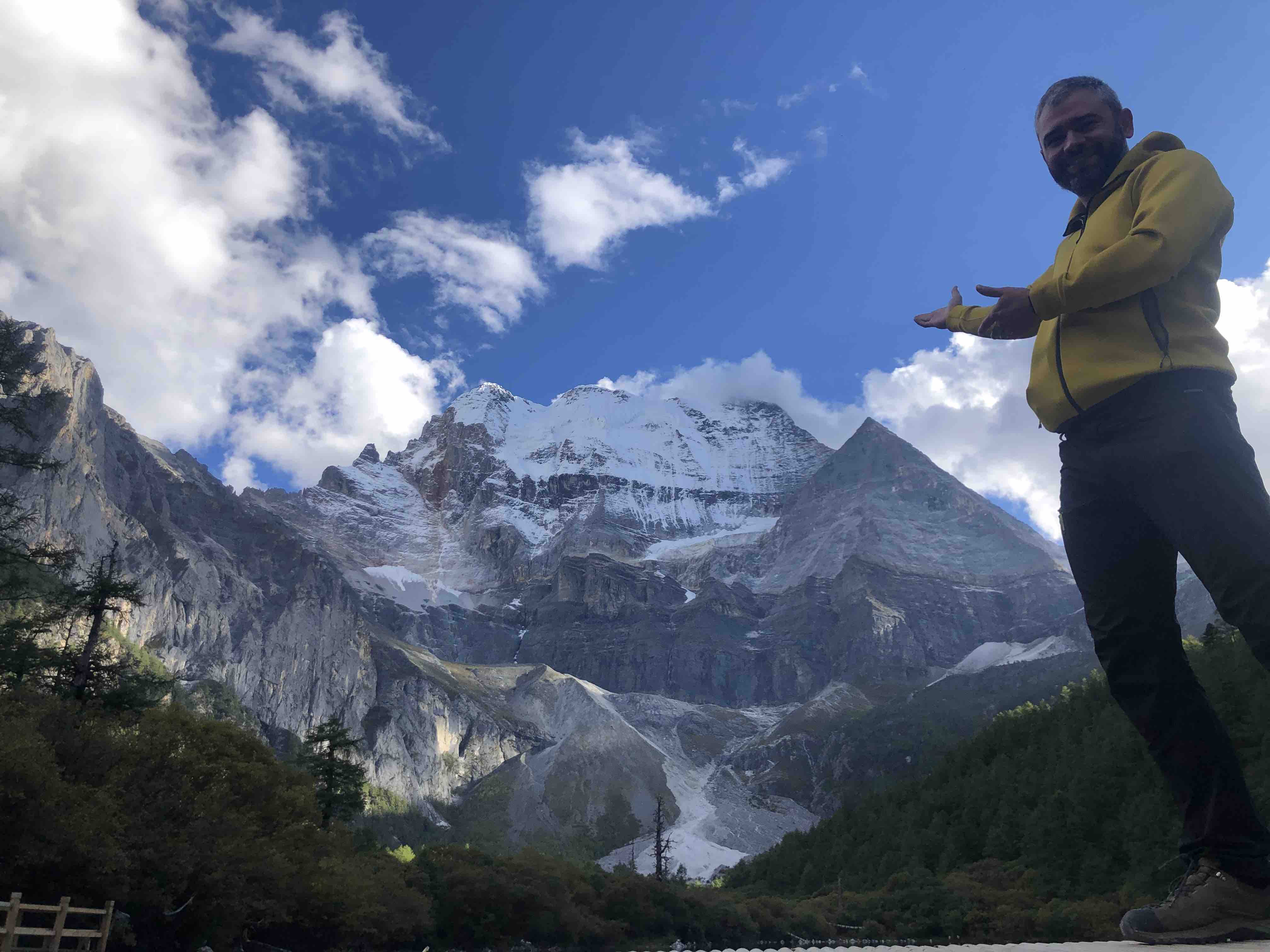
Koszuk on a camping excursion to Yading Mountain, Sichuan. Image via Pacha Mama Adventures
“Because I own a travel company, I have lots of people contact me and say, ‘Hey, I have this glamping site, come visit.’ But for me, I'm not super interested, Pacha Mama Adventures is something different.”
Instead, Koszuk has decided to try and offer more wild camping experiences, taking his customers deeper into rural China. This year, he plans to organize a trip to Yading, a national reserve in the south of Sichuan province.
The journey will start with a hike into the Holy Three Peaks of Yading and end with the group camping among three sacred mountains. It will be a difficult journey that could reach elevations of up to 5,000 meters. However, the journey will be made easier, as Koszuk plans to hire mules to help carry the gear up the mountain.
Speaking about why he’s not following the glamping trend, Koszuk says: “I think it's just about recognizing my customer base and what people want. Obviously, I still have to see whether my new ideas about organizing trips in more remote areas can pick up or if I can find a crowd of people who are interested in it, but this is how Pacha Mama Adventures has always done it.”

Yading Mountain, Sichuan. Image via Pacha Mama Adventures
Before the recent surge in glamping, China had a camping history dating back more than 150 years. More recently, specifically over the last decade, camping was more of a niche sport for hardcore outdoor enthusiasts, who became known as ‘donkey friends’ or 驴友 (lüyou) in Chinese. Now, around 3% of China’s population, or 30 million people go camping every year, while in the US it’s 10% of the entire population.
Given the growing interest in both camping and glamping, the outdoor gear and apparel market has reacted and access to top-class gear has become easier. In 2018, the market for outdoor and camping gear in China, including tents and apparel, reached USD60 billion and is estimated to reach USD100 billion by 2025.
Of the almost 1,000 outdoor gear brands across the world, over half are Chinese. This is a staggering fact, especially since the Chinese outdoor equipment industry only picked up during the early 90s.
“When I used to look on Taobao for camping gear, they'd only be a select few shops and they would all sell the same kind of stuff,” Bennett says. “Now, it's overwhelming how much stuff there is to buy. I’ve upgraded my gear three or four times and you can even rent stuff on Taobao.”
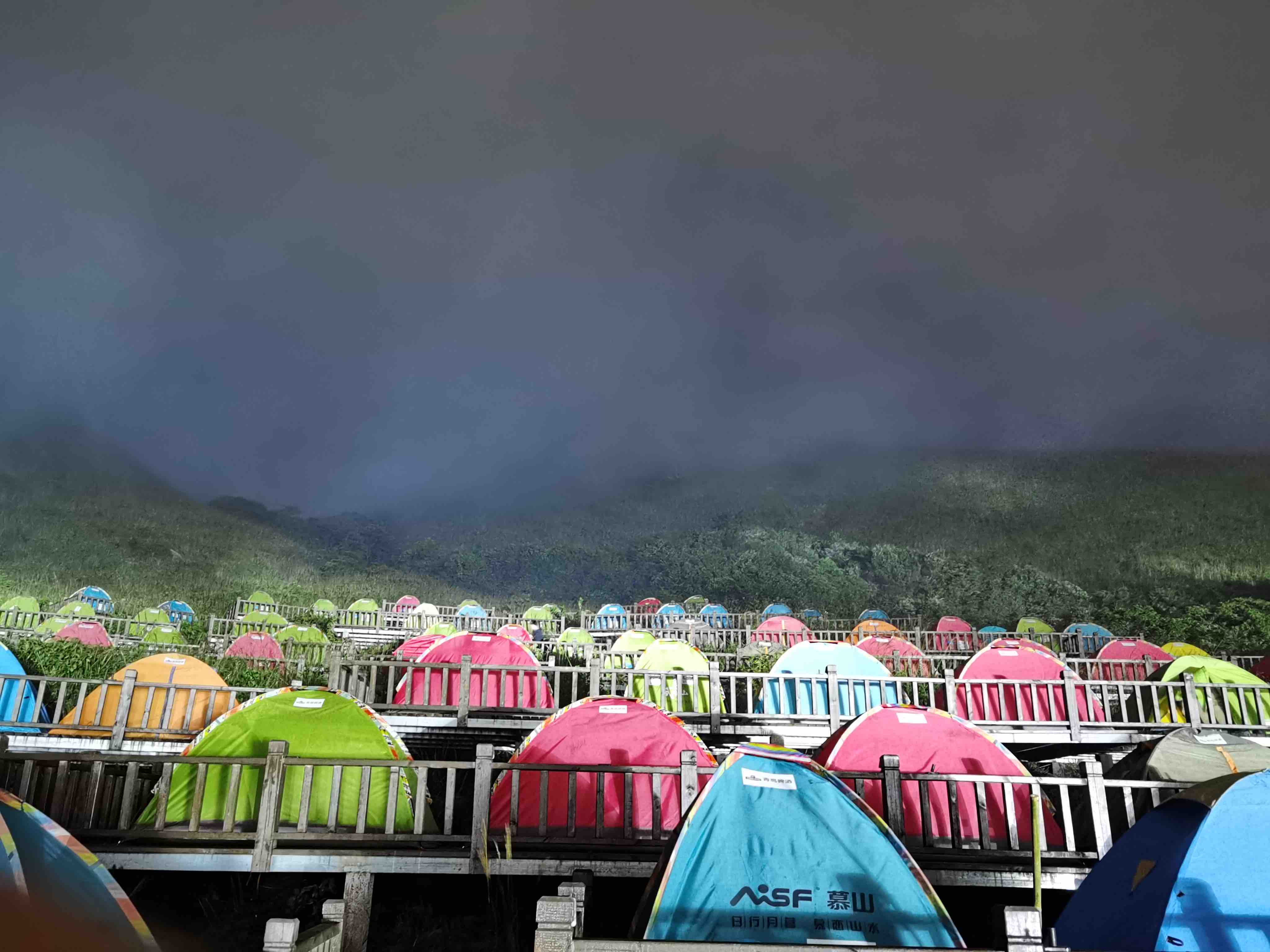
The campsite on Wugong Mountain, Jiangxi province. Image via Pacha Mama Adventures
Access to better equipment is not the only positive to come from the glamping and camping rise in popularity. As more people take an interest, the quality and safety of campsites will improve. Also, there are organizations now offering the experience for children during the school holidays, so students have more opportunities to connect with their natural surroundings and get outside to keep active.
Camping may have seen a surge in popularity due to the COVID-19 pandemic, but the market’s reaction suggests that it is a craze that’s here to stay. Although glamping may not be for the purists, it is moving ever closer to their world and simultaneously changing the outdoor recreation landscape in China.
Six of the Best Camping Spots in China
Yading National Park

Image via Pacha Mama Adventures
Where:
Sichuan
Best time to go:
July - October
How to get there:
Fly to Daocheng Yading Airport and then take a taxi or drive to Yading National Park. At the park’s entrance, take a shuttle bus to Yading village, the base of the National Park.
Difficulty:
This hiking camping trip is difficult or very difficult depending on your fitness level.
Be aware of:
Daocheng Yading airport is located at an altitude of 4,400 meters, which can cause some people to feel altitude sickness as soon as they step off the plane. It’s recommended to take altitude sickness tablets and buy an oxygen tank at the airport to minimize symptoms.
It’s the kind of trip that requires good planning and preparation. The weather can be unpredictable and temperatures can drop to zero degrees Celsius on the mountain, even during the summer.
Hikers need to have waterproof hiking boots, jackets, a down jacket, a down sleeping bag, a good quality tent and a mat. It’s best not to hike alone, ideally you should go with a group or join an organized tour.
Why you should go:
This is a truly epic hiking route that loops around three sacred Tibetan peaks and is dotted with spectacular glacier lakes.
Luokeng Grassland
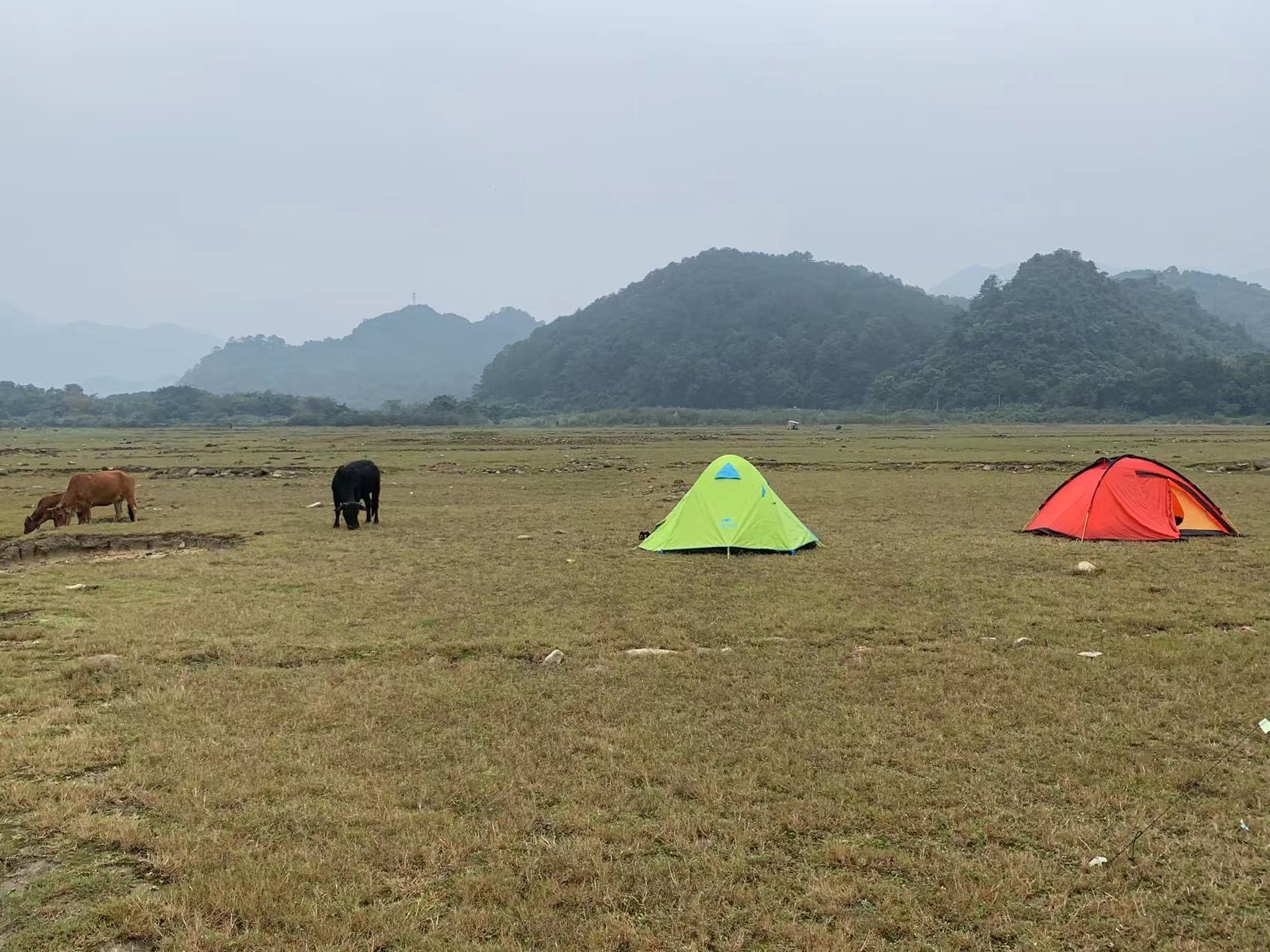 Image via Pacha Mama Adventures
Image via Pacha Mama Adventures
Where:
Guangdong, Yingde
Best time to go:
This camping spot is accessible all year round, but it’s at its most beautiful during the summer and most comfortable during the fall.
How to get there:
Take the high-speed train to Yingde from Shenzhen or Guangzhou. If you’re outside Guangdong province, arrange your trip to either of the two cities accordingly. Once you arrive in Yingde, organize a private car (such as a DiDi to Luokeng Grassland).
Difficulty:
Easy. This route has some hiking routes if you want to take them, but the area for camping is easy to get to and relatively flat. Campers can rent camping gear on site and you can even buy firewood!
Why you should go:
The camping area is unrestricted so you can set up base camp wherever you like! There is a beautiful stream to take a swim and a natural cave that can be explored, all for free!
Wugong Mountain

Image via Pacha Mama Adventures
Where:
Jiangxi province
Best time to go:
July - August
How to get there:
Take a high-speed train to Pingxiang North station in Pingxiang city. If you live in a city that doesn’t have train access to Pingxiang, look at flying into Jiangxi province and then organize travel from there. Once in Pingxiang you need to get a taxi to Wugong Mountain. Public transport is available, but a taxi will be much easier.
Difficulty:
If you decide to hike the natural trail from the bottom to the top, this route is classified as difficult. If you want to make it an easy route, take the cable car to the top of the mountain.
Be aware of:
Wugong Mountain has an altitude of almost 2,000 meters and it can be a bit chilly at night, even during the summer.
Tents are available to rent at the top of the mountain, but it’s worth bringing your own sleeping bag.
Avoid public holidays as rental prices have been known to triple and the experience might be less enjoyable.
Why you should go:
Wugong is a very unique mountain with grassy peaks. You will find very diverse vegetation, ranging from alpine forests to bamboo forests near the bottom of the mountain. Because of the high altitude, it’s quite common to see a sea of clouds on top of the mountain, which is an amazing sight during sunrise.
Ham Tin Beach
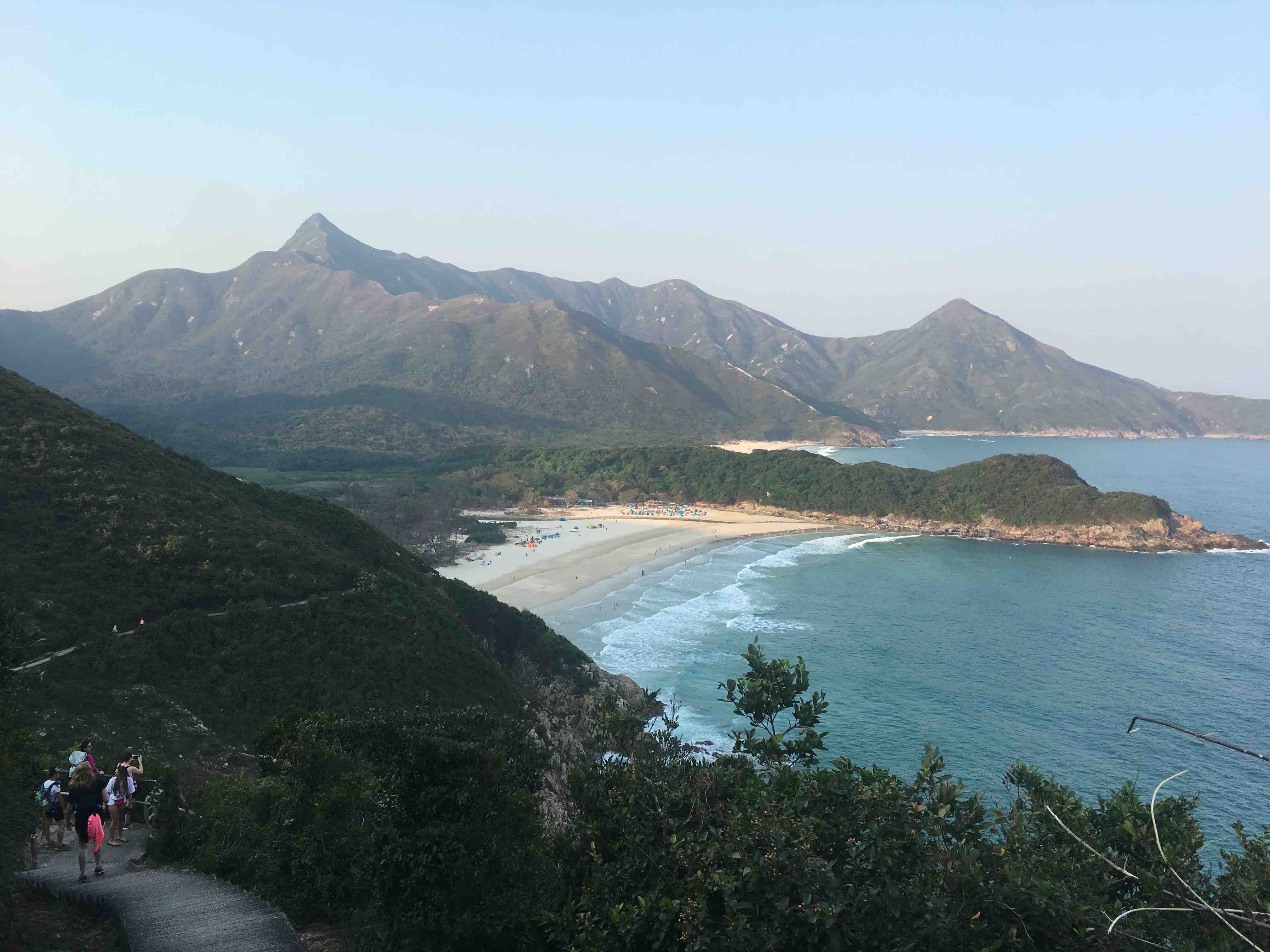
Image via Pacha Mama Adventures
Where:
Hong Kong, part of the MacLehose Trail
Best time to go:
September to November, as it’s too hot to camp during the summer.
How to get there:
If you live outside of Guangdong and there are no trains to Hong Kong where you live, your best bet is to get to Shenzhen and then cross the border.
If you can take a train, head to Kowloon Station. From there get a bus to Saikung, then transfer to bus 94, which will take you to the beginning of the MacLehose Trail. From there you can walk to the beach.
Difficulty:
Moderate. Hiking the MacLehose Trail can take a few hours. If you don’t want to hike, you can take a private boat to the beach from the port in Saikung. However, if the sea is rough, the boat isn’t available.
Be aware of:
The protected areas of Hong Kong are quite wild, watch out for snakes and wild boars.
It’s possible to rent camping gear at the restaurant on the beach. There are also showers available.
Why you should go:
Firstly, when Hong Kong does open, can you think of a better way to spend your first time back there than camping on a beach? And let’s not forget the captivating views of the rugged coast, impressive peaks and the golden sand. There is even a waterfall with an awesome 8-meter-high cliff jump.
Sanmen Island (Baishawan Beach)
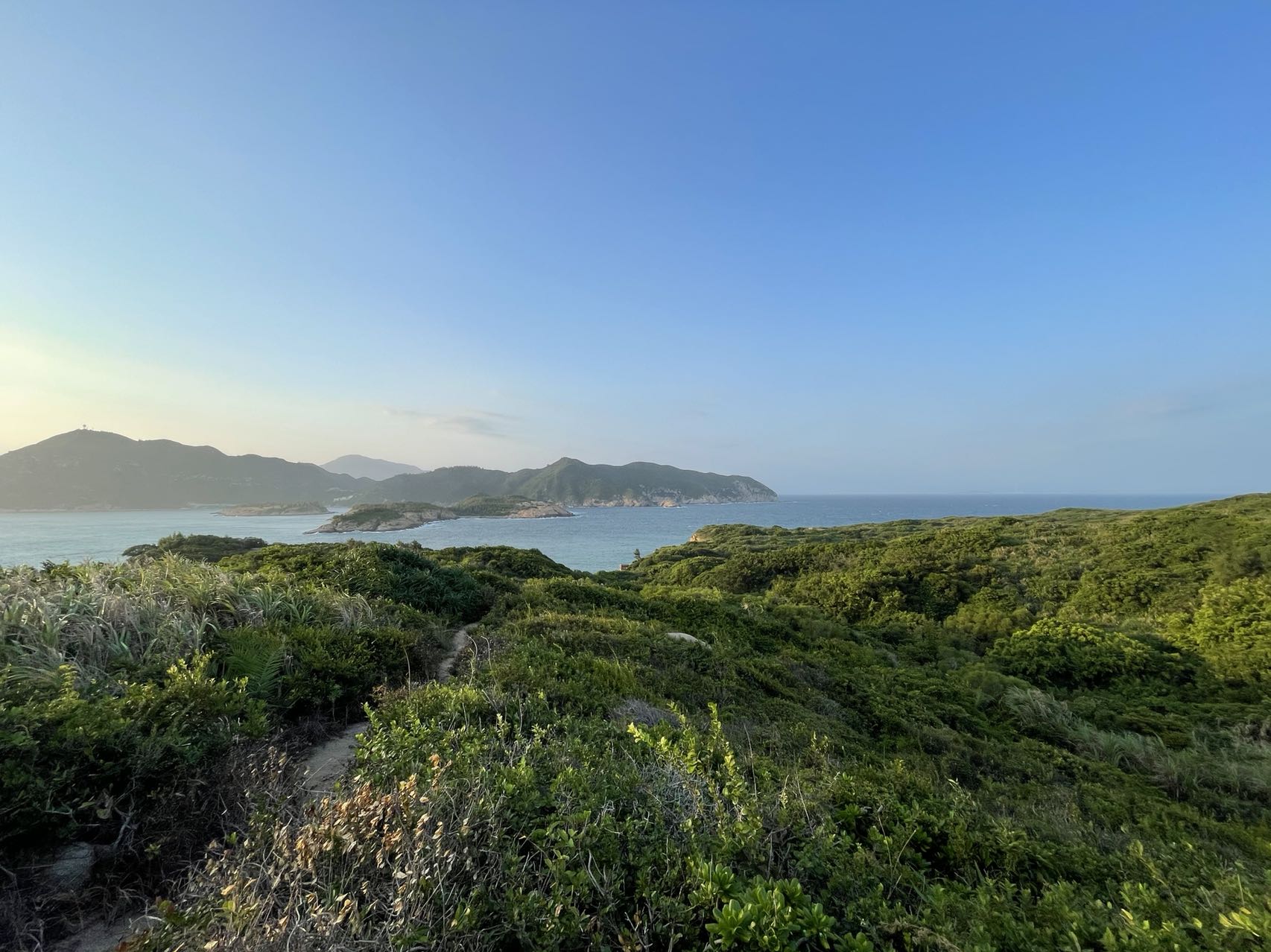
Image via Anwar Bennett
Where:
Dapeng Peninsula, Guangdong, just off the coast of Shenzhen.
Best time to go:
September to November, as it’s too hot in the summer.
How to get there:
Take a private boat from Dongchong beach. The price of the boat can range between RMB300-600, so it’s best to go with a group or share the cost with other people who are on the way. If the sea is too rough, the boat won’t go to the island.
Difficulty:
Easy, no hiking!
Be aware of:
This particular island beach doesn’t have any guards so you can camp there without restrictions. But there is no dock, so getting off the boat when there are strong waves is difficult.
There are no stores on the island, so make sure you have plenty of supplies.
The island has two beaches that you can camp on, one of them is near where the boat will drop you off and the other is a walk across the island.
You can also camp on the top of the island which has a fantastic view, but be wary of the weather, the wind is very strong up there!
There are two Sanmen Islands, the other one is an abandoned holiday resort and although it is cool to see, it’s not great for camping.
Why you should go:
The views are magnificent and the fact that the beach is unguarded gives a great sense of freedom. It’s also great for sunbathing and swimming in the ocean.
The Great Wall

Image via Pacha Mama Adventures
Where:
Miyun County, about 130km north of Beijing.
Best time to go:
Avoid the winter months (November – February) if you don’t like the cold.
How to get there:
Once you’re in Beijing head to Dongzhimen station and take bus 980 to the Drum Tower, it takes around two hours. From there, you need to take bus 25 to Gubeikou, your entrance to the Great Wall.
Difficulty:
Moderate. This trip can be as difficult or as easy as you want it to be, depending on how far you want to hike on the wall. Some sections of the wall have been refurbished for tourists but some are original and, as such, centuries old. If you choose to scale the wild sections then use extreme caution as there are steep ledges, near-vertical staircases and loose stones. When your priority is to deter the Mongol Hordes, workplace safety isn’t usually a consideration.
Be aware of:
Camping is prohibited on some areas of the Great Wall, so please double-check before you pitch your tent. We have provided information on how to camp at the Gubeikou section of the wall, where camping is allowed.
Some areas of the Great Wall are less developed than others and there can be tripping hazards or falling rocks, watch your step!
If you see barriers or signs warning you against crossing sections of the wall, please heed their instructions.
Why you should go:
Who wouldn’t want to tell their friends they camped on the Great Wall? Also, as it’s far away from the big city, you can see the stars at night. Don’t forget to wake up early and watch the sunrise over the wall.
[Cover image via Anwar Bennett]





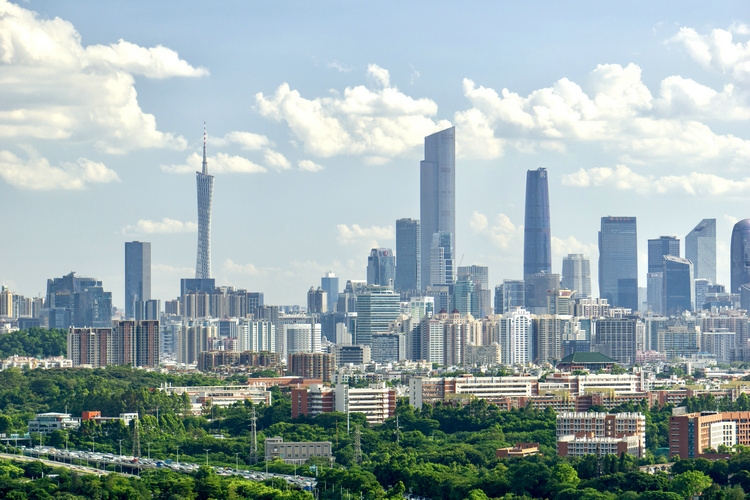















0 User Comments